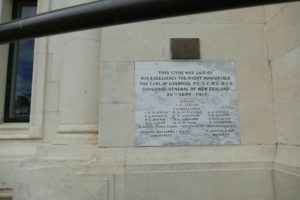22 Nov Murray Crawford: Who really designed the Sarjeant Gallery?
There are surely more chapters to come following Rachel Rose’s thought-provoking article “Time to Salute Young Architect Genius”, (Chronicle: October 20).
Anyone with a sense of justice will agree that Donald Hosie deserves proper recognition for his competition-winning design of the Sarjeant Art Gallery.
That he “met a glorious death at Paeschendaelle” [sic], (Chronicle: September 8, 1919) after submitting his entry only adds to the tragedy (although what was so glorious about being blown to bits amidst the slaughter, mud and blood of World War I is beyond our comprehension today).
Rose writes of the competition judge interviewing Hosie and his boss Edmund Anscombe in a bid to determine the true authorship of the plans, coming to the conclusion they were Hosie’s, but that the local council of the day ignored his findings.
The following is not to question what has been presented so far, but to throw more light on the subject, particularly as the Chronicle also states: “Closely allied with him [Anscombe] had been his gifted pupil Donald Hosie ……. In him they mourned a youth of surpassing promise. Personally he mourned the death of a dear friend.”
A letter was recently passed to me from Ailsa Stewart. It was addressed to Stewart and her father, former harbourmaster Captain R.D. Stewart and was written by their architect friend Ian Dunn, who once worked for Miller & White (the firm which took over Anscombe’s) and who visited the Stewarts in 1984.
The men talked blokes’ stuff, but the conversation turned to the Sarjeant when Dunn spotted a book which featured the gallery. Dunn then told how the winning design for the building was first sketched roughly by Hosie on the back of a serviette while dining with a friend in a London restaurant, never dreaming it would achieve such celebrity. Dunn claimed to have attended architectural college with Hosie and his friend, so he knew both men. Following are the relevant parts of Dunn’s letter:
“Memo to:- Ailsa and Capt. Stewart,
Sarjeant Gallery page 16
Donald Hosie came into Anscombe, Dunedin with his idea for the Art Gallery a few days before the closing date for the competition. Hosie worked for Anscombe who said, OK, you send it in under the firm’s name because you’re not NZIA. So Hosie and the boys worked on the drawings night and day over a weekend and finished the design in time. I think Anscombe and staff had been working on the competition at the same time, i.e. and their solution, which was sent in also. Hosie was outstanding in his ability, and his loss in the war was regretted by many in the profession who knew him. It was generous indeed of Anscombe to give credit to Donald Hosie at the opening of the building and also of the writers of the book to record the fact…… I worked for Miller & White and became a partner following World War II, so have been aware of Hosie and his worth…….”
The book Dunn referred to was Wanganui Buildings of Historic Interest, illustrated by Des Bovey. As noted in Dunn’s letter, page 16 featured the gallery, but also noted the praise given Hosie by Anscombe.
So it’s plain that according to both the Chronicle and Dunn, credit was given to Hosie at the opening. But questions remain.
Was it commensurate with the effort put in by the young architect? Was the finished design largely his own work or was it substantially modified by Anscombe?
Follow-up reports relate the effort put in by Anscombe, particularly in the area of presentation of art works and modern lighting techniques to bring the gallery up to world class standards. Was Anscombe’s praise a belated attempt at diverting the judge’s suspicions that he was claiming Hosie’s design for himself?
Was it, as has been suggested, that the council desired an architectural name of distinction to adorn the foundation stone, rather than that of an unknown student?
Or is it partly due to the inevitable fading and merging of memories over the years. It should be noted that Hosie, with Anscombe, had won at least two previous architectural competitions – the first a ladies’ public lavatory and the second an animals’ drinking trough.
Further research may shed more light on the matter, but whatever is revealed it’s clear that Hosie’s contribution should again be recognised when the gallery is reopened, particularly in light of his comment before going off to war: “I am a young man and will have my chance again.”
This piece appeared in the Whanganui Chronicle on 17 November



